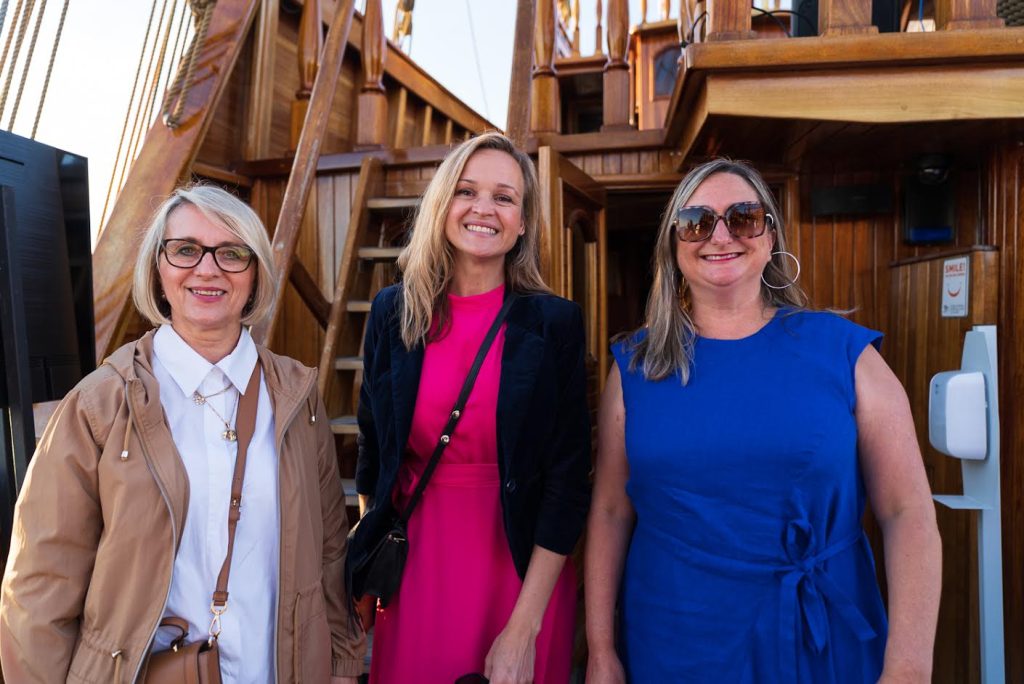When I was a child, my mother always referred to Baranja as a fairy land. Couldn’t understand it back then, but do understand now. With its silver misty meadows, elegant vineyards, picturesque villages and soothing sounds of nature, Baranja lives a quiet life within Hungarian border and two mighty rivers the Danube and the Drava. Quiet but vivid life, not entirely as if time has stopped, feels more like stepping into another dimension the moment the thin line that separates Baranja from the rest of the world has been crossed.

I spent many summer holidays in the little village Batina some 30 (wow!) years ago , fishing and swimming in the Danube River, more swimming than fishing, because I was never good at fishing, would either let the fish swim away or lose fishing hooks by hooking surrounding trees or rocks in the river. We used to go to the village well to get drinking water, have an ice cream from the small ice cream shop or a soft drink at the „Buffet at Ilija“ by the Danube during evening strolls and would go to Fiš Paprikaš Competition at nearby Zeleni otok. Those are the moments I still carry in my heart. My father used to teach us how to react if we come across a group of wild boar walking through the woods on our way to the fishing spot or how to swim if we get caught in the river whirlpool. Those were the lessons I could apply in so many life situations afterwards. Sandy Danube beaches, green woods, coexistence with mosquitoes, playing by the old pear tree, exploring around the village and all over Banovo brdo (Baranja hill) with my brother and cousin were the summer adventures I had just 50 km from my hometown Osijek and have never missed the Sea.

I am a grown woman now, the little cottage we had doesn’t exist anymore, I don’t live in Osijek anymore but my love for Baranja didn’t stop. On the contrary, it’s getting stronger. So, allow me to introduce you to the land of wine, top gastronomy , fertile fields, Nature Park Kopački rit, magnificent wild animals and plants, picturesque traditional villages, farm stay households, surduks, gators, events, manors, cute little churches and baranjske pustare – workmen settlements.
As the Baranja is the subject to write about many posts in the future, I shall put down a few things to get started. I hope other bloggers will follow too.

1. „The Mother of Wine“ – the first vineyards in Baranja were planted by the Romans who named the Baranja Hill “Mons aureus” – golden hill. The name of Baranja means Mother of wine, it got its name from two Hungarian words: -bor meaning wine and –anya meaning mother. Baranja is rich in wine growing and there are so many winemakers, it is hard to choose which one to visit or write about. Personally, I was lucky enough to discover the Kolar family a few years ago. I’ll never forget it… it was Saturday noon, the beginning of November, and I was wandering around Baranja, meeting people, discovering new stories and information. I knew little about wine, at the time, but wanted to do wine tasting. I didn’t know any winemaker, didn’t have any idea to whom should I go to and somehow I incidentally ended up at the Kolar cellars. That was the moment the doors of a whole new world opened to me, the world of wine. Entering the charming Kolar premises in the little village Suza, I had the honor to meet Papa Kolar and his son-in-law. I will not bother you with the details how ignorant I was claiming not to love white wine and how Papa Kolar changed my opinion forever during a one-hour education and wine tasting on the wine cellar tour. Over time I met the dear female side of the Kolar family too. Why do I worship the Kolar family so much? It is not only about great wine, it is about how warm and welcoming these people are. Beside their century old cellar, they also run a restaurant placed in the gator, and if you want to stay longer and explore Baranja they also offer bed & breakfast accommodation and a little gorgeous cycling camp. There are many more wine cellars on 8 wine roads of Baranja such as Kalazić in Batina, wine gallery Gerštmajer and wine cellar Josić in Zmajevac, family cellar Szabo and vinoteque Svijetli Dvori in Karanac etc. I promise to write more about wine cellars and wine (graševina, chardonay, white and grey pinot, sauvignon…) in the future.
The Gator is a wine cellar typical for Baranja, dug deep into the side of a hill that could be long up to fifty meters.

2. Baranja gastronomy – The very soul of every Baranja dish, sweet or hot, is ground red pepper. Whether you enjoy meat or fish dish, you can bet it will be red. I mean, really red. Baranja gastronomy goes hand in hand with its natural surroundings, water, fertile soil, wild animals. Some of ‘must try dishes while in Baranja’ are:
Baranja kulen – the yummiest spicy sausage ever (EU Protected Geographical Indication)
Smoke-dried bacon, sausages, ham, čvarci (cracklings), dairy and other delicious homemade products,
Fiš-paprikaš – hot freshwater fish stew cooked on an open fire,
Šaran u rašljama – carp fixed to forked branches and roasted over an open fire,
Perkelt – fish or meat stew served with pasta, cottage cheese and fried bacon,
Venison specialities,
Beans cooked in clay pot

Of course, there is so much more to discover while visiting Baranja with the help of numerous traditional restaurants and farmhouses such as Baranjska kuća, Darocz, Citadela, Josić, Kod Varge, Darócz, Kovač Čarda, Piroš čizma, Didin Konak…

3. Things to do – sightseeing the only town in Baranja, Beli Manastir and villages, visiting manors, churches, monuments and Nature park Kopački rit, cycling through the vineyards, surduks and villages, canoeing in Kopački rit, being wild on off road with Riki, walking, riding a horse or driving in a traditional horse cart, photo safari instead of hunting, birdwatching, wild plant photographing, fishing, wine tasting or being creative on Asztalos pottery workshop at amazing environment of one hundrad old steam mill…

4. Farm Stay B&B of Baranja – If you want to spend some time away from your chaotic schedule, want to relax in easy going surroundings and recharge your batteries Baranja offers a range of farm stay properties you can choose from. Many properties grow their own vegetables and have chickens, pigs, ponies and horses… Special treat is traditional breakfast made of Baranja products such as kulen, cottage cheese, homemade marmalade. Eco Farm Orlov Put, Farm Estate Didin Konak, Eco Centre Zlatna Greda, Family Farm Lacković, Family Farm Matijević well known of kulen producing, Farm Estate Ivica and Marica are the places you can start your search from.
Would also like to mention gorgeous 4 star Hotel Lug with old style wooden rooms, garden, gazebos, orchard…

5. Festivals and cultural events – If you like festivals, to mingle and meet new people Baranja will definitely fulfil your expectations. There is always something going on in Baranja. From Vinceška (the celebration of the new winegrowing year) on St.Vincent’s Day in January, Carnival with “buše” in Februray, Baranja Festival of Church Folk Singing where visitors can enjoy the folk customs, traditional food and old crafts, the wine festival Gator Fest, Slama Land Art Festival , Kopačevo Fishing Days, The Wine Marathon, to Cracklings (Čvarak) Fest and others…

6. Unique Industrial Heritage: Baranjske pustare – The workmen settlements in Baranja have lost their purpose nowadays and their abandoned settlements testify to the once great industrial development and high standards in the agricultural sector. The pustara settlements were built for the workers in the 19th century and had administration buildings, apartments, ambulance, school, shop, even a cinema for more than 50 families that used to live in the larger pustara settlements. Baranjske pustare under threat of being demolished and lost for good.

7. Manor houses in Baranja – These parts were home for many foreign noblemen who built manors from where they could manage their big estates. The first one here was Prince Eugene of Savoy’s Manor in Bilje, built in the first half of the 18th century. Tikveš Manor Complex with main building and hunting lodge probably built by Fridrich Habsburgin 19th century. Both manors are placed in Bilje region. There are two more, the Esterházy Manor in Darda built in the second half of the 18th century and the Kneževo Manor built in 1828.

8. No Tower Church – The Church of St. Peter and Paul was built in 1722 in honor of Prince Eugene of Savoy’s victory over the Turks at the famous Battle of Senta on 11th September 1697. This monumental baroque church is placed near Topolje and is known as the church with no tower which was a good enough reason for the local people to create legends over the centuries about it.

9. Nature Park Kopački rit – is the oldest nature park in Croatia, established in 1976 and one of the best preserved flooded areas in Europe due to the impact of the Dunav and the Drava rivers. Almost a third of the nature park has the status of the special zoological reserve. In 1993, it was included in the List of Wetlands of International Importance, especially as a residence of wading birds. It is characterized by different types of vegetation: forests (white willow, black poplar, oak), grassland and wetland and aquatic plants. Water surfaces are covered by water lenses, pondweed and water lilies. You can enjoy and witness the wildlife of Kopački rit on a boat tour, by following the walking trails or taking birdwatching and photo safari tours. Did you know that big cormorant eats a few kilos of fish a day? And that white tailed eagle wing span can go up to 2,5 meters?

10. The World of Wild Animals and Plants – Baranja is a haven for all animal and plant lovers. It is impossible to make a list of all species in this post, not to mention going into details. So, to make a long story short, Baranja is the world of at least 2000 of animal and plant species, 55 species of mammals (deer, wild boar, hind, wild cat, badger, squirrel, fox…), 298 species of birds (white-tailed eagle, black stork, the Ferruginous Duck, white herons and geese…), 10 species of reptiles, 11 species of amphibians and 44 species of fish. Seeing these beautiful creatures in their natural environment is a wonderful experience, but listening sounds of it is the next fascinating thing you can do. You simply must visit Kopački rit during Septemeber and hear the ‘love sound’ of deer roaring.

As for the plants, shall mention The unique steppe meadow at the moment, the only remaining steppe meadow in Croatia where can be found about 140 plant species, some of which are rare and endangered.
Dreamy landscapes, traditional lifestyle, picturesque villages, peaceful coexistence with nature, numerous legends and beliefs, food and wine joys are great reasons why you were supposed to start your trip to Baranja… yesterday.
To learn more about this amazing region, check out Senka’s Slavonia Baranja Travel website.









